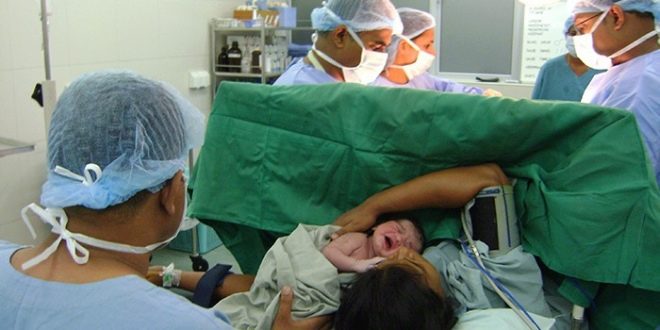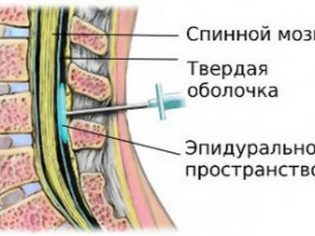Possible effects of epidural anesthesia during childbirth
Epidural anesthesia has been known to mankind for more than a century, but it has received widespread use only recently. The method of pain relief is especially widely used during childbirth, both natural and surgical. Much is known about the merits of anesthesia, but in this material we will talk not so much about them as about the possible consequences of such anesthesia. Is it safe and harmless epidural anesthesia?
About anesthesia method
Epidural anesthesia is a method of anesthesia, in which a drug that reduces sensitivity to pain is not injected into a muscle or into a vein, but into the spine, or more precisely, into its epidural space. It has a large number of nerve endings. When a drug with an anesthetic effect enters this space, the nerve endings are blocked and stop sending impulses, including pain, to the brain. This method is also called peridural, and it refers to regional anesthesia, which makes it possible to anesthetize certain parts of the body, and not the entire patient.
Painkillers in the epidural space is administered via lumbar puncture. For anesthesia of childbirth, medicinal solutions are introduced into the space between the first and second vertebra of the lumbar spine, and for caesarean section, where anesthesia requires a deeper and longer duration, the anesthesiologist chooses a space in the range from 2 to 5 lumbar vertebra.
If there is a need to anesthetize the stages of labor in natural labor, the dosages of the drugs will be significantly lower than the dosages for surgical delivery. Exact doses are determined in relation to each individual case. the taller the woman’s height, the more drug is required to block the spinal segments.
The first epidural was conducted in the distant 1901, introducing cocaine to the patient in the sacral spine. And only 20 years later, doctors learned to anesthetize the lumbar and sternal.
Advantages and disadvantages
The undoubted advantages include the selectivity of anesthesia - a woman maintains clarity of mind and consciousness, she can hear and see everything that is happening, and also communicate with doctors. If a cesarean is made using such anesthesia, then besides the opportunity to hear the first cry of the baby, there is the possibility of an early application of the baby at the breast, which has a positive effect on lactation.
During the operation, the cardiovascular system continues to operate normally, no blood pressure surges are observed. The upper airways are not irritated like a tube for general anesthesia.
The disadvantages of this method of anesthesia should be treated very carefully. So, epidural anesthesia:
- has contraindications;
- depends in terms of results on the qualifications and accuracy of the doctor’s actions - careless movements, erroneous actions can lead to serious consequences;
- has a long latent period - after the introduction of drugs into the epidural space of the spine, the desired effect does not occur immediately, but after 15–20 minutes;
- in about 17% of cases, regional anesthesia does not have the desired effect, it is insufficient or inadequate;
- has after application side effects - back pain, headaches.
Technique of
Execution of the procedure requires special training from the anesthesiologist and great accuracy. After treatment of the outer skin with an antiseptic, a woman is placed on her side while lying or sitting with her head and shoulders low (back "arc"). The doctor inserts a thin, special needle into the space between the vertebrae for lumbar puncture. Overcoming the ligaments, the needle enters the space, which is called the epidural.
Making sure that the exact hit (needle freely enters and does not meet resistance), the doctor introduces a catheter and a test dose of the drug. In a few minutes, the woman’s condition is assessed. Then enter the rest of the dose.
If necessary, the doctor can add the drug at any time when it is needed, since the catheter remains in the spine.
Negative consequences
Peridural anesthesia is not as safe as it may seem at first glance. Penetration into the internal space of the spine has its own risks and may be associated with various complications.
So, in women with reduced blood clotting, hematomas appear at the puncture site with subsequent blood penetration into the cerebrospinal fluid. When an experienced doctor performs the procedure, the likelihood of complications is low. But a not very qualified specialist who has little experience can injure hard spinal membranes, and this can threaten with leakage of cerebral fluid, disorder of the functions of the central nervous system.
Another injury is not excluded - when the needle injures the subarachnoid space of the spine, located slightly deeper than the epidural. In this case, the consequences may be more serious. A woman in this case develops a convulsive syndrome, she loses consciousness, serious violations of the central nervous system are recorded. In the most difficult cases, temporary or permanent paralysis of the lower limbs may occur.
Violation of the integrity of the epidural space during puncture is often the cause of prolonged headaches. Quite noticeably sore back.
The allegations that such anesthesia does not affect the child do not correspond to reality. The drugs penetrate into the blood, however, to a lesser extent, so children in the womb also receive their portion of anesthetic, which can sometimes cause the development of respiratory failure, hypoxia and heartbeat disorders in the newborn after birth. It should be noted that reliable and accurate data on how the epidural affects the child does not exist - this issue is still under study, there is little information to draw any conclusions.
The procedure itself causes fear and psychological discomfort. The hardest thing is for those who have a planned caesarean section. In addition to the well-understood fears of the outcome of the operation, women are afraid of the process itself, because they will practically be present at their own surgical delivery, and this is quite difficult.
In addition, there are other complications:
- the occurrence of severe tremors after drug administration as a reaction of the nervous system;
- prolonged numbness of the limbs - with time passes;
- inflammation at the puncture site, infection in the spinal canal;
- allergic reaction to the anesthetic drug;
- slowing down the production of breast milk (under the action of drugs, lactation processes slow down, milk may appear later).
Recovery from epidural anesthesia is somewhat easier and faster, the anesthesia is more gentle, without vomiting and nausea. This type of anesthesia does not affect the severity of rehabilitation after childbirth or cesarean section as a whole, does not reduce or increase the likelihood of complications.
Probability of complications and risk factors
With all the risks of developing negative effects, epidural anesthesia is still considered fairly safe. The point is statistics.It states that complications after the application of this method of reducing pain causes negative consequences in only one case per 50,000 births.
Risk factors are considered by medical personnel to ignore the requirements for contraindications of epidural anesthesia, and the inept actions of the anesthesiologist. The success of the application depends primarily on it, and only secondly on the modern equipment for epidural anesthesia in the hospital, compliance with the requirements of processing and sterilization of instruments. Today, trying to use disposable sterile sets of needles, catheters, which also reduces the likelihood of infection.
It will be safer for mother and child if she receives standard training before the introduction of anesthetic into the epidural space of the spinal column, talks with the anesthesiologist so that none of the existing contraindications go unnoticed.
Reviews
The overwhelming majority of women who gave birth with epidural anesthesia or chose it for caesarean section were satisfied with the result and effect, but note that there were still side effects. This mainly concerns heaviness in the legs, numbness of the extremities, headaches and spinal pains, which sometimes drag on for several weeks after the operation or physiological labor using the epidural.
Those who have experienced the effects of several types of anesthesia sometimes claim that they did not notice the special advantages of epidural anesthesia over the general. In addition, recovery was not as easy as anesthesiologists describe before surgery.
See the next video for the effects of epidural anesthesia.

















